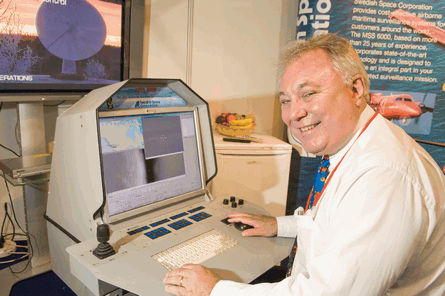Swedish Space Corporation is celebrating the latest success for its MSS 6000 maritime surveillance system. The Finnish Border Guard has selected this advanced air-to-surface sensor suite to upgrade one of its Dornier 228 twin-turboprop patrol aircraft, and has an option to upgrade a second.
The installation on the Finnish aircraft will combine side-looking airborne radar, infra-red/ultra-violet line-scanner, forward-looking infra-red, still and video cameras, and other sensors with an Inmarsat SwiftBroadband 432kbit/sec-per-channel L-band satcoms terminal for air to-ground voice and broadband data communications.
In Finnish service MSS 6000 will be used for a variety of tasks, including the detection and tracking of oil spills in the Baltic, surveys of ship traffic, and search and rescue. Other nations to have selected the system include Sweden, Norway, Poland, Portugal, Greece, the USA and, most recently, Estonia and Canada.
The Estonian Border Guard is now operating an MSS 6000-equipped LET L410 turboprop after completing acceptance tests at the end of last year. The aircraft’s Inmarsat satcoms installation was supplied by Danish manufacturer Thrane & Thrane.
|
|---|
Transport Canada formally accepted its second MSS 6000, installed in a twin-turboprop Bombardier Dash 8, last December. The aircraft is now in service, based in Vancouver, British Columbia, and operating along the west coast and over the western Arctic. Along with MSS 6000 it is fitted with EMS Satcom’s HSD-400 four-channel Inmarsat terminal, CNX-200 router/accelerator and AMT-3800 high-gain antenna.
Transport Canada’s first MSS 6000-equipped Dash 8 has been operational for more than a year from its base at Moncton, New Brunswick, with the primary mission of detecting environmentally damaging deliberate oil spills from ships.
“Inmarsat is a great tool that allows us to deliver evidence from MSS 6000 to the ground very quickly,” says Louis Armstrong, manager of Transport Canada’s National Aerial Surveillance Programme. “Without it we would have a mass of still and video imagery on the aircraft and would have to wait until landing to send it to anybody. Now we can pick the best of the images and send them over the link, and deliver the rest of the evidence package as soon as we land.”
Canada recently ordered a third MSS 6000 for installation in a four-engined Bombardier Dash 7 surveillance aircraft. The system is due to be delivered this summer for use in the Arctic during the shipping season and over the Great Lakes for the remainder of the year.
Source: Flight International

















